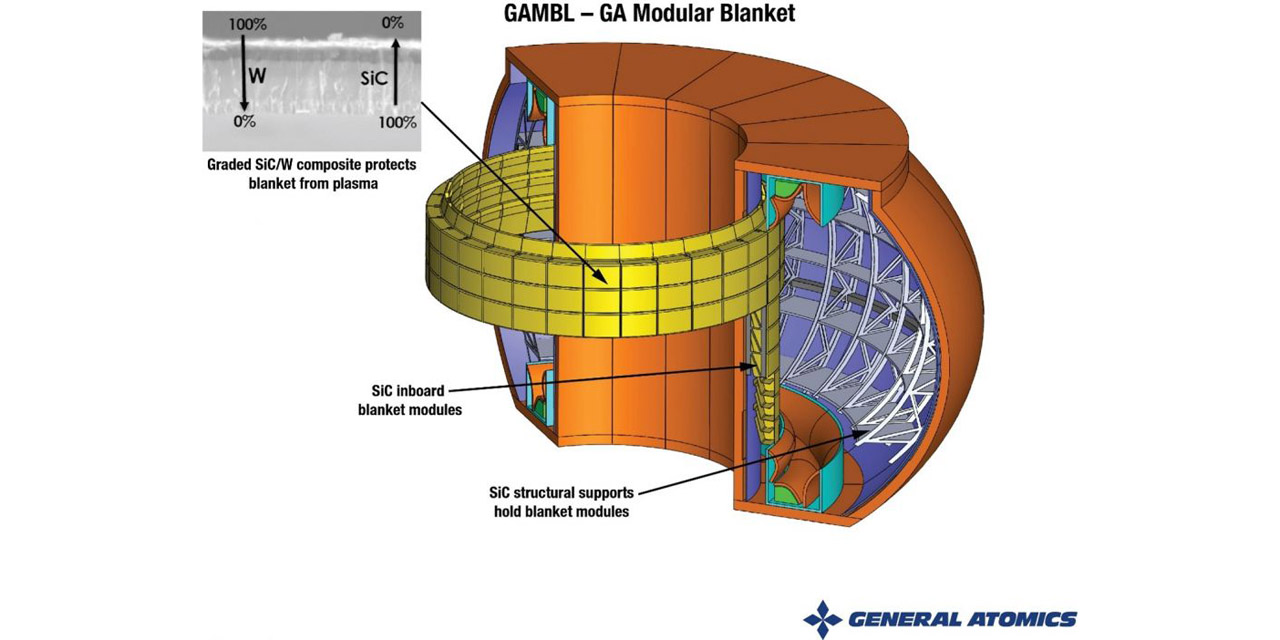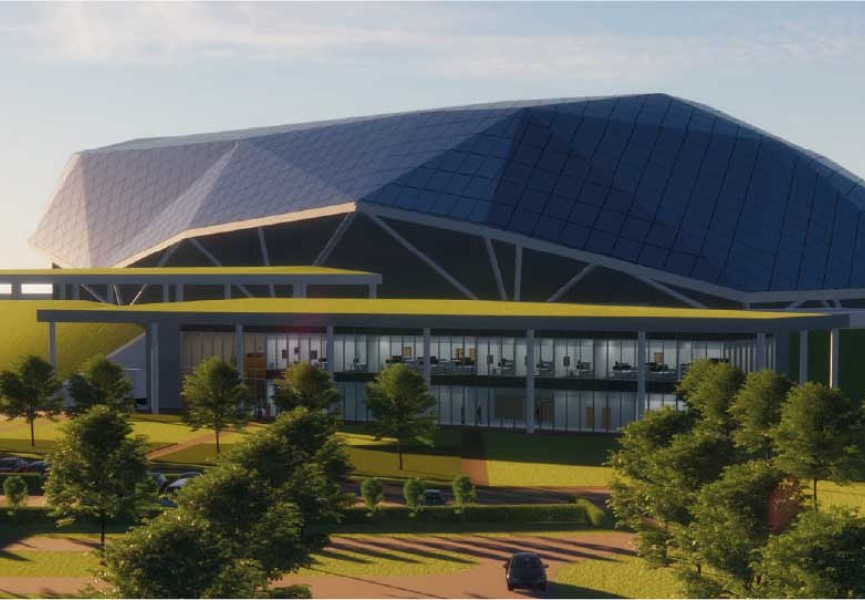A screenshot taken from a INL video demonstrating MAGNET and its digital twin. (Source: INL)
Researchers at Idaho National Laboratory (INL) recently performed their first digital twin test of the Microreactor Agile Non-nuclear Experimental Testbed (MAGNET) and captured the demonstration in a video posted July 14. The digital twin—a virtual representation of a microreactor—was built using advancements in remote monitoring, autonomous control, and predictive capabilities that could help lower operating costs of microreactor technologies and enhance their safety.
A plaque honoring JET’s world record–setting achievement of fusion energy production of 50 megajoules in a single shot (right) and commemorating a 34-year-old bet between Goldston (top left) and Jacquinot (bottom left). (Photo: PPPL and EUROfusion consortium/collage by Kiran Sudarsanan)
A wager struck by two plasma physicists 34 years ago was finally fulfilled in June during the opening day of the 48th European Physical Society Division of Plasma Physics, when Robert Goldston, former director of the Department of Energy’s Princeton Plasma Physics Laboratory (PPPL), virtually presented a plaque to his friend and colleague Jean Jacquinot, former director of the Joint European Torus (JET), EUROfusion's flagship fusion experiment based at the Culham Centre for Fusion Energy in the United Kingdom. Their bet, and JET’s record-breaking achievements in 2021, were celebrated in an article published by PPPL on July 8.
Artist's rendering of Shin-Hanul Units 3 and 4. (Image: KHNP)
South Korea’s new president, Yoon Suk-yeol, appears to be following through on his campaign pledge to reverse the previous administration’s domestic nuclear phaseout plan. Earlier this month, Yoon’s Ministry of Trade, Industry, and Energy announced a new direction for the nation’s energy policy—one that calls for, among other things, a reembrace of nuclear power. A further announcement on the subject last week provided additional details.
A view of Palo Verde-3 and a spray pond, as seen from Unit 2. (Photo: APS)
In the western part of Michigan, where I grew up and spent the early part of my career, water availability was rarely a concern or a topic that might appear in the news. Lake Michigan was a plentiful source of water, and Mother Nature always provided plenty of precipitation to keep things green. If anything, sometimes folks wished it would stop raining! So it was quite a big change in environment when in 2008 my career took me to the desert of Arizona and the Palo Verde Generating Station, with annual regional rainfall totals of three inches in a good year.
This fusion tokamak cutaway illustrates how the GAMBL concept would be incorporated into a fusion pilot plant. The SiC-tungsten composite wall provides superior heat-removal capabilities and durability, and a modular approach enables fabrication using existing technologies. (Image: GA)
Researchers at General Atomics (GA) are proposing a breeding blanket made of modular silicon carbide–based components to withstand the intense conditions in a high-power fusion power plant. The GA modular blanket (GAMBL) concept is described in an article published this month in the journal Fusion Engineering and Design, and was introduced by GA in a July 13 press release.
Artist’s rendering of a Rolls-Royce SMR plant. (Image: Rolls-Royce SMR)
U.K.-based reactor developer Rolls-Royce SMR last week announced a list of six potential sites for its first small modular reactor factory. According to the company's announcement, the factory—the largest and most complex of three such facilities envisioned by the company—will manufacture the SMR vessels.
Rendering of a VOYGR plant. (Image: NuScale)
NuScale Power and Paragon Energy Solutions have signed a patent license agreement that will make NuScale’s Nuclear Regulatory Commission–approved reactor protection system architecture available to the broader nuclear industry, the two companies announced on July 12.
Known as the Highly Integrated Protection System (HIPS) platform, the system was developed by NuScale and Rock Creek Innovations (RCI), a hardware supplier of commercial nuclear protections systems, over six years of collaboration that began in 2010. Paragon, a supplier of safety-related parts and components, acquired RCI in December 2021.
A construction permit was issued for the first of four proposed reactors at Egypt’s El Dabaa site, about 185 miles northwest of Cairo. (Image: Wikipedia)
The Egyptian Nuclear and Radiological Regulation Authority (ENRRA) recently issued the construction permit for the first of four proposed Russian-designed and -supplied reactors at Egypt’s El Dabaa site, located on the Arab nation’s Mediterranean coast, about 185 miles northwest of Cairo.
An application for the permit was submitted by Egypt’s Nuclear Power Plants Authority (NPPA)—the public entity charged with operating the plant—in June of last year.
TVA's Watt Bar nuclear power plant.
As part of its strategy to achieve net-zero status by 2050, the Tennessee Valley Authority yesterday issued a request for proposals for supplying up to 5 GW of carbon-free energy that must be operational before 2029.
The Ringhals nuclear power plant. (Photo: Wikipedia)
Vattenfall has initiated a study to look into the feasibility of building at least two small modular reactors adjacent to its Ringhals nuclear power plant, the Swedish state-owned power company announced recently.
Located on Sweden’s west coast about 37 miles south of Gothenburg, Ringhals holds two operating power reactors: Unit 3, a 1,074-MWe pressurized water reactor; and Unit 4, a 1,130-MWe PWR. The facility is also home to two retired units: Unit 1, a boiling water reactor shut down in December 2020; and Unit 2, a PWR taken off line in December 2019.
July 8, 2022, 7:00AMNuclear NewsBy George Apostolakis, James Ellis, and Steven Nesbit The Diablo Canyon nuclear power plant.
The state of California recently and quite sensibly cracked the door back open for continued operation of the Diablo Canyon nuclear power plant past the current operating license expiration dates in 2024 (Unit 1) and 2025 (Unit 2). The nonprofit North American Electric Reliability Corporation’s recently released 2022 Summer Reliability Assessment highlights the risk of electricity shortages in California. Given that concern, as well as the benefits of continued Diablo Canyon operation—including much needed clean, reliable energy; good jobs; and potential for large-scale production of fresh water—another look at the shutdown decision made several years ago is clearly warranted. Sen. Dianne Feinstein (D., Calif.) reinforced this point when she added her voice to the growing chorus of policymakers advocating extended operation for Diablo Canyon.








.jpg)









